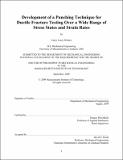Development of a punching technique for ductile fracture testing over a wide range of stress states and strain rates
Author(s)
Walters, Carey Leroy
DownloadFull printable version (8.496Mb)
Other Contributors
Massachusetts Institute of Technology. Dept. of Mechanical Engineering.
Advisor
Tomasz Wierzbicki.
Terms of use
Metadata
Show full item recordAbstract
Advanced High Strength Steels (AHSS) are becoming increasingly popular in automotive design because of possible weight savings due to the high strength. However, traditional methods are not capable of predicting fracture in AHSS, leading to expensive redesign due to poor prediction of stamping and crash worthiness. Many scenarios in which fracture is a concern in automotive applications are in the range of quasi-static through intermediate strain rates (up to 850/s). Studies with high-speed hydraulic equipment and Hopkinson bars have shown that there is a dependence of fracture on strain rate, and that it may be a complex relationship. Recent work on quasi-static fracture has shown that the dependence of ductility on the stress triaxiality and Lode parameter must be accounted for, but this dependence has not been investigated in the dynamic range. The aim of the current thesis is to contribute a new methodology based on an instrumented drop tower that will allow for testing of ductility for low to intermediate strain rates over stress triaxialities ranging from one third to two thirds. The methodology begins with a very in-depth understanding of plasticity based on multi-axial experiments, continues with qusistatic punching experiments, and finishes with dynamic punching experiments. In the punching experiments, a thin sheet is clamped into a circular die and loaded in membrane tension through out-of-plane punching. The state of stress is changed from equi-biaxial to approximately uniaxial through the introduction of cutouts in the sides the membrane specimen. (cont.) The quasistatic punching experiments are verified against a multi-axial fracture testing technique previously demonstrated by other researchers. From application of the aforementioned methodology to a steels used in sheet metal forming and crash worthiness, the current thesis has shed insight into the dependence of ductility on stress triaxiality, Lode parameter, and strain rate for quasi-static to intermediate strain rates.
Description
Thesis (Ph. D.)--Massachusetts Institute of Technology, Dept. of Mechanical Engineering, 2009. This electronic version was submitted by the student author. The certified thesis is available in the Institute Archives and Special Collections. Cataloged from student-submitted PDF version of thesis. Includes bibliographical references (p. 111-114).
Date issued
2009Department
Massachusetts Institute of Technology. Department of Mechanical EngineeringPublisher
Massachusetts Institute of Technology
Keywords
Mechanical Engineering.